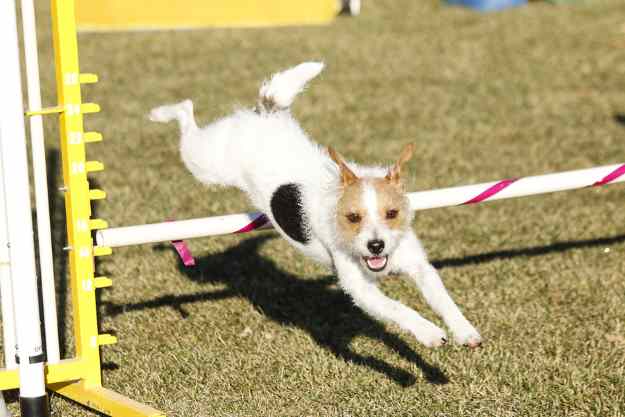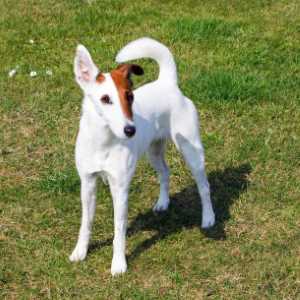Meet the Wire Fox Terrier
by Janice Jones |Last Updated 08-26-2021
If you're looking for a small dog that is full of life, very inquisitive, and quite smart, the Wire Fox Terrier might be the breed for you.
Here is the ultimate small dog with a huge personality. The best way to describe these dogs is that they live life to the fullest, never missing a chance to play, dig, run, hunt, chase, bark or amuse their people. But wait, this breed might seem perfect but there's always a downside.
If you are considering one of these dogs, do read the personality section carefully. Expect to be entertained by an escape artist who thinks it's his job to bolt whenever the door is opened.
As a terrier, they also live for the hunt but all have a different level of the prey drive. Anything small is fair game to them, so if you have small pocket pets, this breed is not for you. Most also do not like cats.

Quick Facts
Other Names Used: Foxie, Wire Hair Fox Terrier, Wirehaired Terrier
Affiliation: FCI (Group 3 Terriers), AKC (Terrier), ANKC (Terriers), CKC (Terriers), KC (Terriers), NZKC (Terriers), UKC (Terriers)
Size
Height: Male: 14-16 inches (36-41 cm); Female: 13-15 inches (33-38 cm)
Weight: Male: 15-20 pounds (7-9 kg); Female: 13-18 pounds (6-8 kg)
Coat Type: Wire outer coat and soft undercoat
Colors: White, White & Black, White & Tan, White Black & Tan, White Tan & Black
Country of Origin: England
Activity Level: Active
Life Expectancy: 12-15 years
Good with Children: Yes
Good with other pets: No
The Wire Fox Terrier At a Glance
| Traits | Rating |
|---|---|
| Playfulness | |
| Affection Level | |
| Friendliness Towards Strangers | |
| Good with Children | |
| Good with Other Dogs | |
| Good for First Time Owners | |
| Exercise Needed | |
| Ease of Training | |
| Watch Dog Ability | |
| Grooming Requirements | |
| Shedding | |
| Cold Tolerant | |
| Heat Tolerant |
Dog Breed Ratings Got You a Little Confused?
Here's a little help in understanding them
- Playfulness: Most Playful = 5 Least Playful = 1
- Affection: Most Affectionate = 5 Least Affectionate = 1
- Friendliness Towards Strangers: Most Friendly = 5 Least = 1
- Good With Children: Great= 5 Not Good with Children = 1
- Good With Dogs: Great = 5 Not Good Around Dogs = 1
- Good With First Time Owners: Fine=5 Not Appropriate = 1
- Exercise Required: Extensive Daily Exercise = 1 Minimal = 1
- Ease of Training: Very Easy = 5 Difficult = 1
- Watch Dog: Excellent Watch Dog = 5 Minimal = 1
- Grooming: Time Consuming = 5 Minimal = 1
- Shedding: Heavy Shedder = 5 Minimal = 1
- Cold Tolerance: Well Tolerated = 5 Poor Tolerance = 1
- Heat Tolerance: Well Tolerated = 5 Poor Tolerance = 1
History
 History of the Wire Fox Terrier
History of the Wire Fox TerrierThe Wire Fox Terrier can trace his heritage to England during the period when fox hunting became popular around the late 1700s. They were also used on farms to hunt vermin.
Fox hunting enthusiasts used them to bolt the fox from its den enabling the hounds and hunters on horseback to chase them over the open countryside. Their mostly white coats allowed hunters to distinguish them from the red foxes being pursued.
It’s believed that the breed came from the rough coated black and tan terrier of Wales, Derbyshire, and Durham which is now extinct.
Most of the early terriers used were dark in color and shorter than today's dogs. Hunters needed a dog with long legs with high endurance that could run alongside the horses and foxhounds.
They needed dogs that could "go to ground," meaning enter foxes dens and then "bolt" the foxes to drive them out of their hiding places. Thus, the fox terrier was developed. Hunters found that those with the wire coats were less vulnerable to injury in the rough terrain, so they became more popular over the smooth fox terriers at the time.
Even though there are scant records, early breeders crossed the wire fox terriers with smooths to get more white hair and improve the overall outline of the dog.
Interbreeding continued up to the time when both types of fox terriers were considered different breeds in the early 1900s. Except for the type of hair coat, both the Smooth and Wire Fox Terriers are fundamentally the same.
Wire Fox Terriers were not only popular with fox hunters, but also with nobility. King Edward VII owned a wire fox terrier named Caesar.
The breed was never popular as a family pet until the 1930s, and they can trace that popularity back to a couple favorite movies and pop culture. Asta, the wire fox terrier, was a member of the Charles family in The Thin Man series beginning in 1934 and continuing into the 1940s.
Snowy, another wire fox terrier, was featured in the Adventures of TinTin Comic Strip created by cartoonist Georges Remi, who wrote under the pen name Hergé. The first of this series was published in 1929 and was very popular in Europe.
Both the Smooth Fox Terrier and the Wirehaired Fox Terrier were recognized by the AKC in 1985.
By the end of the 20th century, the popularity of the breed declined as a pet, but they continue to be popular and highly successful in the show ring. “King,” the wire fox terrier won best in show at Westminster in 2019.
Personality/Temperament
Their mischievous nature makes them amusing and fun to be around, but with so much personality comes a few drawbacks. They love to dig. They love to chase, and they love to bark. Just these three traits alone can make them a difficult dog to own.
They need a securely fenced yard in which to play and explore Check the fence periodically as they also love to dig and can become quite the escape artist if given the opportunity.
Often these dogs are relinquished to shelters and rescues for some of the very reasons people found them adorable as puppies. They may run away, chase cars and bikes or even buses.
They will chase and attack other animals. One must remember why they were developed in the first place: to hunt and chase. They are fearless.
The ideal owner will always need to be one step ahead of the dog, require firm control, and provide enough stimulation with exercises and mental activities to keep them amused.
It goes without saying that the ideal owner will also be willing to making training an ongoing priority throughout the dog’s life. This breed may not be an ideal choice for first-time owners.
They make excellent watchdogs but if their barking gets out of control, it might be challenging to discern whether there is a good reason or whether they are just barking out of boredom.
Children
This is a wonderful breed if you are looking for a small dog that is sturdy, tireless, and friendly with children. Their insatiable desire to play along with their steadfast loyalty makes them an excellent choice for very active children.
With that said, these dogs not only crave attention, but they also need it continuously, and if not given enough outlets for their energy and intelligence, they can become bored. A bored dog is not a happy dog and can become a problematic companion.
Dogs and Other Pets
The wire fox terrier is a happy go lucky kinda guy but not when it comes to other dogs. They often do not play nice and have been known to pick fights, even with dogs twice their size.
They also tend to chase smaller
pets and even cats, which makes them a poor choice if you have other pets.
Small, pocket pets are never safe as the wire considers them to be prey. Early
socialization and training is a must to divert their strong prey drive.
 A Happy Wire Fox Terrier in a grassy field.
A Happy Wire Fox Terrier in a grassy field.Coat & Grooming
Wire fox terriers have a dense, wiry outer coat that is more crinkly than curly. Their undercoat is soft Like other terriers with a harsh or wire outer coat, owners of the Wire Fox Terrier have a choice in the way they groom their dog: clipping or stripping.
Most pet owners will opt for clipping because it is easier and less costly. Some will even do this themselves at home using a dog clipper and shears. The majority, though prefer to schedule visits with a professional groomer about every 4 to 6 weeks.
Clipping tends to soften the coat, dulls the color somewhat, and it may be a bit harder to keep clean as the soft coat will attract dirt.
The other method of keeping hair neat, shiny, and manageable is with hand stripping. This is the only way to preserve the wiry coat and hair color and is done by individuals who show their Foxy in conformation shows.
They either learn to strip the coat themselves or pay someone to do it for them. This is a costly process, so learning to strip is definitely recommended.
Beyond clipping or stripping, you will want to keep your dog clean with the occasional bath. Nails will need to be trimmed or ground down using a Dremel tool, and ears checked and cleaned as needed.
Dental health is also important, so invest in a toothbrush and some toothpaste and accustom your dog to having his teeth brushed as often as possible.

Health Concerns of the Wire Fox Terrier
Wire Fox Terriers are healthy and have a long lifespan of 12 to 15 years, but like all dogs,, they are susceptible to all the same health issues that are often preventable such as infectious diseases and parasites.
Some health issues have a genetic link, and some of those can be controlled through testing and clearing breeding stock before allowing them to mate. Many of these issues are very common in many small breed dogs such as patellar luxation, Legg-Perthes, elbow and hip dysplasia, and eye concerns.
There are three major eye issues that can cause pain and blindness. Glaucoma is a painful disease that leads to blindness if left untreated. Symptoms in dogs include watery eyes, blue cornea and redness in the whites of the eyes. In advanced cases, the eyes appear enlarged and bulging.
Cataracts are a common cause of blindness in dogs including Fox Terriers. The lens of the eye looks opaque, and cloudy and the dog eventually loses his sight. Surgery can remove the cataract and resore vision.
Primary lens luxation (PLL) is an inherited disease, that causes the tiny fibers that hold the lens suspended within the eye to degrade and break. This leads to the lens falling forward and blocking normal circulation to the eye. Surgery may be necessary to relieve pain.
A neurological condition called “wobbler’s gait” has also been identified in the breed. Wobblers disease occurs when the vertebrae in the neck pinches the spinal cord and other nerves. These pinched nerves can't send signals to the brain which means that the dog can't feel his feet. The outward signs are unstable hind legs which causes stumbling and falling. Treatment includes medications, braces, rehabilitation, exercises, and surgery.
Seizures and Epilepsy is sometimes inherited in the breed especially primary or idiopathic epilepsy where there is no obvious cause such as a brain tumor, trauma, or stroke.
This Breed is Best Suited For
The Wire Fox Terrier can be challenging to novice owners because of their high energy level, tendency towards behaviors that can be challenging and can be difficult to train.
It takes a dedicated, consistent, and strong person to do well with this breed. There are so many rewards, but first time dog owners may find the challenges outweigh the challenges.
Energy and Activity Level
All terriers are active and have the energy to spare. They require a decent amount of exercise to satisfy both the mental and physical needs. Long walks and playing fetch or running around in a fenced in yard will typically keep them happy. When outdoors, it's wise to keep them on a leash unless you are in a securely enclosed area.
Even the best dogs who have excellent recall can get excited or distracted, especially if something perks their interest and they will bolt at a second’s notice. Remember they were once used to catch small prey animals (vermin on farms) so anything that moves, squirrels, chipmunks, little rabbits, will be considered prey by your Wire Fox Terrier and thus fair game for a chase. (No pun intended)
The best way to keep your foxy happy is to provide plenty of exercise. Remember the old saying, “A tired dog is a good dog.” Unfortunately, most people will tire out before their dog does so it might take a bit of ingenuity on your part to provide all that exercise needed.
Training
Terriers are notoriously intelligent, spunky and fearless, traits that make them so much fun to be around, but your bold little Foxy is going to require plenty of patience and consistency on your part to train, socialize and teach some house manners. They respond to positive training methods using praise and rewards such as treats. If you like the idea of dog sports, they do great in agility and earthdog trials.
Like many small breed dogs, the wire fox terrier is challenging to housebreak. Patience is required and crating will help keep accidents from happening frequently.

Feeding
Fox Terriers dogs thrive on a high quality food that
Dog foods made with good grains such as brown rice or quinoa are a good choice. Most dogs will eat between 1 and 1 1/2 cups of food per day. Healthy snacks can be provided in moderation and most love veggies and fruits.
Sometimes supplements are required to address specific health issues and a daily multi-vitamin, mineral, antioxidant supplement can't hurt.
Pros of Living with A Wire Fox Terrier
- Friendly, loyal companion that craves attention
- Loves to play
- Good with Children
- Fun, loving
- Good Family Dog
Cons:
- Has several bad habits due to the breed’s history: chasing, digging, barking
- Can be grumpy with other dogs and may pick fights
- May not do well with small pets
- Hard to housebreak
- Highly energetic-may be destructive if not given enough exercise
- Fairly rare: May be difficult to find
References
Related Breeds
C2 Share Your Experience Living with a Wire Fox Terrier
I love to receive comments and feedback from my site’s visitors—everything helps make this site even better. Why not join in and share your thoughts about what you just read.
If you found this article or site helpful or enjoyable, I always appreciate a “Like” or “Share” or a +1.
Your “Likes” on our Facebook page help us too.
Come back soon,
Janice
About Janice (author and voice behind this site)
Janice Jones has lived with dogs and cats for most of her life and worked as a veterinary technician for over a decade. She has also been a small-breed dog breeder and rescue advocate and holds academic training in psychology, biology, nursing, and mental health counseling. Her work focuses on helping dog owners make informed, responsible decisions rooted in experience, education, and compassion.
When not writing, reading, or researching dog-related topics, she likes to spend time with her six Shih Tzu dogs, her husband, and her family, as well as knitting and crocheting. She is also the voice behind Miracle Shih Tzu and Smart-Knit-Crocheting
Does This Article Deserve Your Thumbs Up?
We always appreciate your support and encouragement. Your thumbs up means so much to us. Please like this article.
If you find this page or any page on Small Dog Place Helpful, or useful in anyway, I'd love it if you would click the small heart found on the bottom right of each page.
You can also share or bookmark this page -- just click on the:

Free Monthly Newsletter
Sign Up for Our Free Newsletter and get our Free Gift to You.
my E-book, The Top 10 Mistakes People Make When Choosing a Dog (and how to avoid them)




